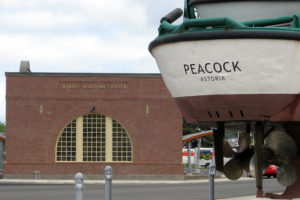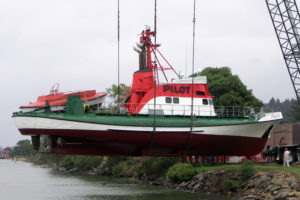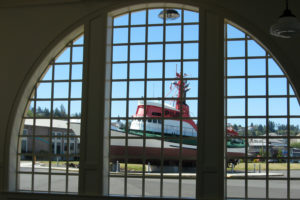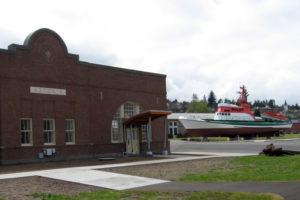The Columbia River Maritime Museum completed the total restoration of the old Astoria train depot last winter and re-opened this historic building as a maritime craft center. The depot was re-named the Barbey Maritime Center in honor of the Barbey family — pioneers in the Columbia River salmon packing industry. A wide variety of marine-related crafts will be taught in the center, where the original layout offers two spacious teaching rooms.
The classes are for all skill levels and cover a wide range of crafts, drawing from both Western and Native American maritime cultures. They range from traditional wooden boat building and decorative ropework, to Native American carving and basket weaving. Classes will be small, and each student will have the opportunity to interact with instructors who have been chosen for their expertise and ability. “You will go away from these courses with the knowledge and confidence that you can create things out of wood, metal, or rope, from a bentwood box to a cast-bronze oarlock,” says Sam Johnson, executive director of the CRMM.
The depot dates from 1925, but the the railway line along the south shore of the Columbia River actually reached Astoria in 1899. It soon replaced the riverboat as the fastest connection with Portland, and carried up to eight passenger and freight trains a day, delivering fresh fish on ice to Portland’s markets and restaurants overnight. The original Astoria depot was a wooden structure located on the bank of the Columbia, and was replaced with a fine stone building in the building boom after the 1922 Astoria Fire that destroyed the entire downtown.
Architecture and History of the Depot
The Spokane, Portland and Seattle Railroad owned the line, and hired Thomas D. McMahon, the Great Northern Railway architect best-known for the Many Glacier Hotel in Glacier National Park, to design the new Astoria Railroad Depot in the innovative “Prairie School” style. The depot has two wings separated by a covered breezeway: the east side was for freight, the west wing for passengers, further divided into two beautiful coffered and paneled waiting rooms, the western-most reserved for women and children.
 It was only a few years after the new depot was completed, that motor vehicles began to supplant the railroad in the Willamette Valley. The road to Astoria was gradually improved and passenger service along the lower Columbia was discontinued after World War II. The Astoria Depot continued to be used for freight handling until 1952 when the line was closed. In 1987 Burlington Northern Railroad gave this historic landmark to the Maritime Museum.
It was only a few years after the new depot was completed, that motor vehicles began to supplant the railroad in the Willamette Valley. The road to Astoria was gradually improved and passenger service along the lower Columbia was discontinued after World War II. The Astoria Depot continued to be used for freight handling until 1952 when the line was closed. In 1987 Burlington Northern Railroad gave this historic landmark to the Maritime Museum.
Maritime Museum Creates A New Landmark—the Pilot Boat Peacock
In 1989 the depot was used as a boat shop to build the replica of a sailing gillnetter now on display in the museum. Then it sat idle until 2002-2005, when a summer excursion service operated during the Lewis and Clark Bicentennial. Johnson was appointed director of the museum early in 2010 and led the effort to raise funds to put the retired 88-foot Columbia Bar Pilots’ boat Peacock on display.
With its whaleback decks, stern ramp, and 23-foot daughter boat, this sophisticated German designed and built craft had revolutionized pilotage on the dangerous bar when it arrived in 1967. After 40 years, it had been overtaken by new technologies–the high-speed planing hull and the helicopter–and was donated to the museum by the pilots. The 83-ton displacement hull required two of the biggest truck-mounted cranes in the Northwest to lift it out of the Columbia, across the parking lot, and onto a solid base beside the highway. There it stands high above the traffic as a permanent memorial to the seamen and pilots who made the Great River of the West the gateway to the Inland Empire.
A New Track for the Astoria Depot
Next, Johnson turned his attention to the restoration of the adjacent depot, which was badly in need of attention. The project began in 2011 and included seismic reinforcements–and repairs to the crack caused by the Oregon earthquake of 1993. The elegant Palladian arched windows and high ceilings in the waiting rooms were expertly refinished, giving the interior a unique historical ambiance. It was completed a year later in 2012 at a cost of over $2 million, and emerged from the process looking as elegant as it had when it opened.
The former depot is remarkably well-suited to its new role: the large freight room has four sliding doors perfect for moving lumber and boats around, with plenty of light from its high windows. At the west end, the open-plan layout favored by the Prairie School offers a spacious classroom and a lecture hall that look out across the train tracks to the river, where there is usually at least one ship or smaller commercial vessel in motion. Today, the Barbey Maritime Center is a rare architectural gem that recalls a bygone era, preserves historic crafts, and has become a part of local life again.
 Of course, the depot and the Peacock repesent only the latest additions to the Columbia Maritime Museum, whose world-class exhibits cover the entire history and culture of the Columbia River! See the CRMM website for full details and list of classes. and a guide to all the museum’s exciting displays at www.crmm.org
Of course, the depot and the Peacock repesent only the latest additions to the Columbia Maritime Museum, whose world-class exhibits cover the entire history and culture of the Columbia River! See the CRMM website for full details and list of classes. and a guide to all the museum’s exciting displays at www.crmm.org


